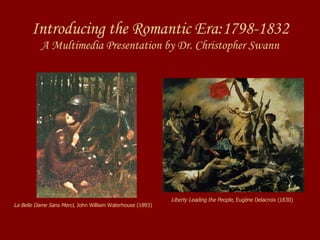
The Romantic Era (1798-1832)
- 1. Introducing the Romantic Era:1798-1832 A Multimedia Presentation by Dr. Christopher Swann Liberty Leading the People, Eugène Delacroix (1830) La Belle Dame Sans Merci, John William Waterhouse (1893)
- 5. English Civil War (1642-1660) After Queen Elizabeth I’s reign (1558-1603), religious and political grievances which had lain more or less hidden under the surface came to life. Under Elizabeth, the Anglican Church—created by Elizabeth’s father Henry VIII—held to the middle of the road between Catholicism and Protestantism. Puritans, a sect of Protestantism, worshiped and even held positions of authority within the Anglican Church in the time of Elizabeth. When Elizabeth died and James I became king in 1603, this situation changed; James I did not conceal his hostility of Puritans and, as head of the Anglican Church, began dismissing Puritan clergyman. James I’s son, Charles I, was even worse in the eyes of the Puritans, not least for marrying the daughter of the king of France, a Catholic. As most of the English were Protestants, this fact alone alarmed much of the nation. Charles’ attitude and behavior did not help the situation—he demanded strict conformity from Puritan clergy, extorted loans from his subjects to finance unpopular wars, and generally seemed determined to be, in the words of Charles Dickens, “to be a high and mighty king not to be called to account by anybody.” Portrait of Charles I, Anthony van Dyck (c. 1635)
- 6. English Civil War (1642-1660) Continued Eventually arresting Parliament leaders who protested against his policies, Charles further alienated the Puritans as his archbishop, Laud, brutally and publicly persecuted Puritans, even mutilating their faces. This lead Puritans to question the entire concept of the “divine right” of Charles’ rule and to make the following revolutionary statement: “A King is a thing men have made for their own sakes.” Such a statement suggests that if a king can be made, then a king can also be unmade, an idea that both infuriated and terrified Charles. In 1642, Parliament condemned Charles as a tyrant, and when Charles sent armed men into Parliament to seize opposition leaders, the leaders escaped, Parliament raised its own army, and Charles fled north with his loyalists, setting off civil war. The king’s supporters, known as Cavaliers because they were largely skilled horsemen or cavalry, fought against the Puritan’s New Model Army, led by Oliver Cromwell. In 1645, Cromwell defeated and captured Charles I. Meanwhile, the most radical Puritans took control of Parliament, shut out more moderate members, and on January 1, 1649, beheaded Charles I and declared England’s monarchy abolished. Oliver Cromwell, 1650
- 7. English Civil War (1642-1660) Continued The English Commonwealth became the new government of England, replacing the monarchy, and was led by Oliver Cromwell. However, the execution of Charles I led to a decline in popularity for the Puritans, whose severe policies outlawing gambling, newspapers, and theater exacerbated the situation. Cromwell had to rule as a virtual dictator until his death in 1658. As a result of public anger at Puritan policies, Parliament reconvened and asked Charles II, the son of Charles I, to become king, which Charles did in 1660, restoring the monarchy. Question #2 : Name two examples (one each) of how both Charles I and the Puritans acted in ways that created tension and made conditions in England worse.
- 35. The Enlightenment, while an era of great scientific and industrial progress, was unable to address the social, political, and emotional stressors seething under the surface. Revolution brewed and then finally exploded in France. New modes of expression blossomed. A new respect and love for the common man, for the individual, took root… The vanguard for this new era consisted of poets, each unique, all dedicated to the ideals of a new age…
- 36. The Romantic Era William Blake (1757-1827) Painter, Poet, Visionary “ The Garden of Love” and “The Tyger” William Wordsworth (1770-1850) “ Father” of Romantic Poetry The Prelude and “Tintern Abbey” Samuel Taylor Coleridge (1772-1834) Poet of the Imagination “ Kubla Khan” and Rime of the Ancient Mariner George Gordon, Lord Byron (1788-1824) Scoundrel, Womanizer, Poet “ She Walks in Beauty” and Childe Harold’s Pilgrimage Percy Bysshe Shelley (1792-1822) Romantic Revolutionary “ Ode to the West Wind” and “Ozymandias” John Keats (1795-1821) “ Greatest” Romantic Poet? “ La Belle Dame sans Merci” and “Ode on a Grecian Urn” “ First Generation” “ Second Generation”